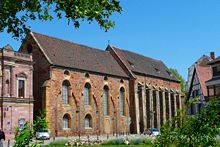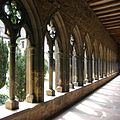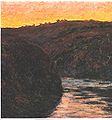- Unterlinden Museum
-
Unterlinden Museum 
Established 1849 Location 1, rue d' Unterlinden
68000 ColmarType Art museum
History museum
Design museumVisitor figures 200,000 per year Director Pantxika de Paepe, née Béguerie[1] Website www.musee-unterlinden.com (English) The Unterlinden Museum (officially Musée d'Unterlinden, also cited in English as Musée Unterlinden) is located in Colmar, France, in the Alsace region. The museum, housed in a 13th century Dominican religious sisters' convent, is home to the Isenheim Altarpiece by Matthias Grünewald and features a large collection of local and international artworks and manufactured artifacts from prehistorical to contemporary times. The museum bears the quality label Musée de France and is one of the most visited in France outside of the Île-de-France.
Contents
History
 View (from the 18th century loft) of the chapel, constructed 1262-1269,[2] and the Isenheim Altarpiece
View (from the 18th century loft) of the chapel, constructed 1262-1269,[2] and the Isenheim Altarpiece
The museum was established in 1849, the buildings (abandoned following the French Revolution) having been saved by the Societé Schongauer (founded in 1847 by Louis Hugot [3]) and bequeathed to it by the municipality. The collection at first centered around a Roman mosaic found in Bergheim, Haut-Rhin, still displayed today at the place to which it was originally moved, and plaster copies of antique sculptures on loan from the Louvre. In 1852, the focus of the collection shifted dramatically, when the Isenheim Altarpiece as well as most of the other large painted and/or sculpted altarpieces from former Colmar or Upper Rhenish churches, abbeys and monasteries, were installed in the building. The museum opened its doors to the general public in the following year, 1853.[4] As the museum's official website states : "Today the museum covers a surface area of about 5,620 m², including exhibition spaces (4,000 m²), conservation, storage and other work areas (1,370 m²), and offices (250 m²)".[5]
In the 1950s and again in the 1980s, the need appeared for the museum, which had seen a steady growth of the number of its displayed artifacts in every domain, to gain more space by using available surface more appropriately, and was each time addressed as far as the classified character of the building in itself could allow. Today, the Unterlinden Museum currently spreads out over three levels and makes use of every space available in the large complex of buildings. The city of Colmar is currently working to transform the adjacent, Art Nouveau former baths building, into an annex of the museum, in which, by 2012, the modern masters can be displayed permanently. According to the museum's website, "The total area open to the public, which now amounts to 4,000 m², will be enlarged to 6,300 m²".[5]
The collections
With roughly 200,000 visitors per year, the museum is the most visited in Alsace.[6] Famous above all things for the Isenheim Altarpiece by Matthias Grünewald, it also displays a major collection of Upper Rhenish medieval and early Renaissance art, among which the Colmar native Martin Schongauer occupies the most prominent place with several altarpieces and a large number of original drawings, engravings and woodcuts.[7] Other famous names include Albrecht Dürer (engravings only), Lucas Cranach the Elder and Hans Holbein the Elder as well as local painters Caspar Isenmann and Jost Haller. Most of the earliest paintings, however, are the work of anonymous German, Alsatian or Swiss masters, such as the Master of the Stauffenberg Altarpiece. Other sections displayed by the museum are : local and international archeology; medieval, Renaissance and baroque sculpture (religious as well as profane) and stained glass; weapons, furniture, music instruments and toys from the 14th to the 19th century; ancient, ornate wine barrels (a collection donated by Jean-Jacques Waltz in 1927); modern and contemporary art.[4] Because of a general lack of space, this last collection, although very well furnished (works by Pablo Picasso, Jean Dubuffet, Fernand Léger, Serge Poliakoff, Georges Rouault, Pierre Bonnard, Robert Delaunay, Maria Helena Vieira da Silva and others) is only seldom displayed in its entirety. The 2012 enlargement of the building by the Swiss architects Herzog & de Meuron[8] is explicitly meant to address this problem.
Gallery
-
Gallo-Roman mosaic from Bergheim, Haut-Rhin (detail)
-
Upper Rhenish Master, Madonna with Child aka. Virgin of Niedermorschwihr
-
Martin Schongauer, Orlier Altarpiece (detail)
-
Hans Holbein the Elder, Portrait of a Lady
-
Lucas Cranach the Elder, Melancholy
-
Ruckers harpsichord from Flanders, built 1624
-
Théophile Schuler, "The Chariot of Death (1848)
-
Claude Monet, Creuse Valley at Sundown
Sources
- Le Musée Unterlinden de Colmar, Sylvie Lecoq-Ramond [former director] & Pantxika Béguerie [director as of 2008], Éditions Albin Michel, Paris, 1991. ISBN 2-226-05411-1
References
- ^ The museum's staff
- ^ History of the building
- ^ History of the Schongauer society
- ^ a b Description of the museum on culture.gouv.fr
- ^ a b Project "the Baths"
- ^ Number of visitors to French museums in 2006
- ^ Samples of the collection on the Base Joconde
- ^ Conseil municipal / Herzog et de Meuron officiels (French)
External links
Categories:- Art museums and galleries in France
- Buildings and structures in Haut-Rhin
- Museums established in 1849
- Herzog & de Meuron buildings
- 1849 establishments in France
Wikimedia Foundation. 2010.













